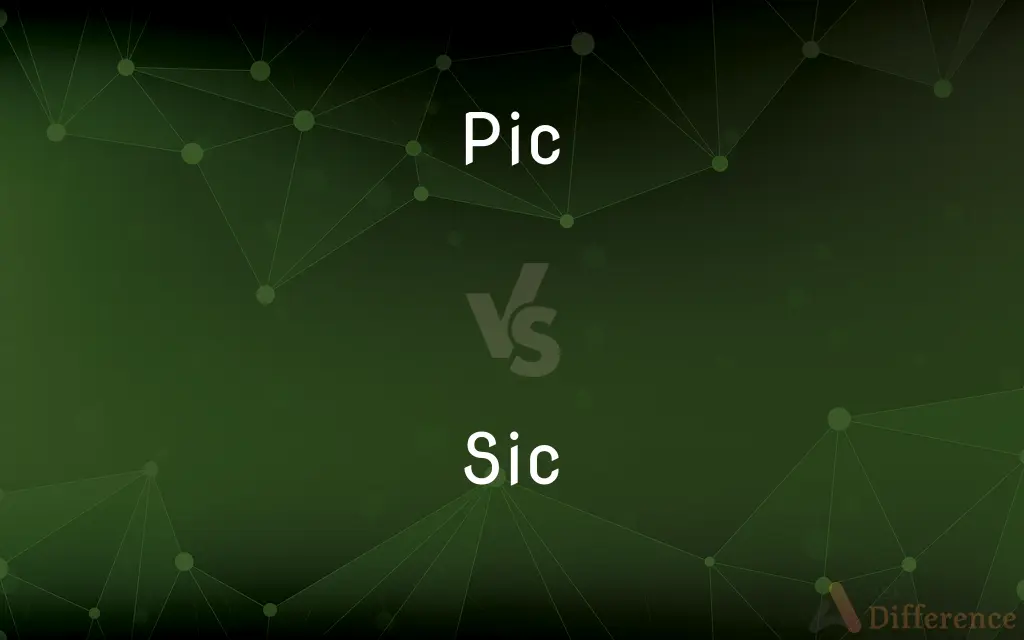Pic vs. Sic — What's the Difference?
By Tayyaba Rehman & Urooj Arif — Updated on April 23, 2024
Pic is shorthand for "picture," typically used informally, while sic indicates an error is reproduced exactly from the original source.

Difference Between Pic and Sic
Table of Contents
ADVERTISEMENT
Key Differences
Pic, a colloquial abbreviation for "picture," is widely used in casual conversation, texts, and social media to refer to any form of image, whether it's a photograph, drawing, or digital image. Sic, on the other hand, is a Latin term used in brackets [sic] to denote that any mistakes or unusual phrases in a quoted text are reproduced exactly as they appear in the original source, highlighting that the error is not a transcription mistake.
The use of pic has become increasingly popular in the digital age, especially with the rise of smartphones and social media platforms that emphasize visual communication. Sic, however, is primarily used in written texts to maintain the accuracy and integrity of quoted material, especially in scholarly, journalistic, and legal documents, where it's crucial to indicate that the original source's errors have been intentionally preserved.
While pic simplifies communication by reducing the length of the word "picture" and making it more casual, sic serves a more formal and specific purpose by alerting the reader to the presence of errors or peculiarities in the quoted material without altering the original quote. This distinction highlights the different contexts in which pic and sic are used: pic in informal, everyday conversation, and sic in more formal, academic, or professional settings.
Another key difference lies in their implications. Using pic implies a casual or informal approach to sharing visual content, often with no need for accuracy or context, whereas using sic implies a commitment to textual fidelity and scholarly rigor, acknowledging that the quoted material may contain errors or idiosyncrasies that are not the quoter's responsibility.
While pic contributes to the ease and speed of digital communication by simplifying language, sic underscores the importance of accuracy, originality, and authenticity in reproducing text, especially in contexts where the integrity of the quoted material is paramount.
ADVERTISEMENT
Comparison Chart
Definition
Abbreviation for "picture."
Latin term indicating exact reproduction of an error.
Usage Context
Informal, everyday conversation.
Formal writing, to denote original errors in quotes.
Purpose
Simplify communication.
Ensure accuracy and integrity of quoted material.
Common in
Texts, social media.
Scholarly, journalistic, legal texts.
Implication
Casualness, informality.
Textual fidelity, scholarly rigor.
Compare with Definitions
Pic
Abbreviation for "picture."
Can you send me the pic from yesterday's event?
Sic
Used in formal writing to maintain originality.
She quoted the typo as it was [sic] to highlight the mistake.
Pic
Used in informal, casual contexts.
I just posted a new pic on Instagram.
Sic
Indicates exact reproduction of an original error.
The document was filled with errors [sic].
Pic
Refers to any type of image.
He has a collection of vintage car pics.
Sic
Shows commitment to textual fidelity.
Despite the error, the quote was included as [sic] to remain true to the source.
Pic
Simplifies communication.
Just saw the cutest dog pic online!
Sic
Emphasizes scholarly rigor.
The academic paper used [sic] extensively to indicate the historical documents' inaccuracies.
Pic
Popular in digital communication.
My phone is full of pics from our trip.
Sic
Alerts readers to intentional preservation of errors.
His tweet was quoted with the misspelling [sic].
Pic
A photograph.
Sic
The Latin adverb sic ("thus", "just as"; in full: sic erat scriptum, "thus was it written") inserted after a quoted word or passage indicates that the quoted matter has been transcribed or translated exactly as found in the source text, complete with any erroneous, archaic, or otherwise nonstandard spelling, punctuation, or grammar. It also applies to any surprising assertion, faulty reasoning, or other matter that might be interpreted as an error of transcription.
Pic
A movie.
Sic
Thus; so. Used to indicate that a quoted passage, especially one containing an error or unconventional spelling, has been retained in its original form or written intentionally.
Pic
(informal) A picture, especially a photographic image.
Sic
To set upon; attack.
Pic
(informal) A movie.
Sic
To urge or incite to hostile action; set
Sicced the dogs on the intruders.
Pic
A Turkish cloth measure, varying from 18 to 28 inches.
Sic
Thus; thus written; used to indicate, for example, that text is being quoted as it is from the source.
Pic
A form of entertainment that enacts a story by a sequence of images giving the illusion of continuous movement;
They went to a movie every Saturday night
The film was shot on location
Sic
To mark with a bracketed sic.
Pic
A picture of a person or scene in the form of a print or transparent slide; recorded by a camera on light-sensitive material
Sic
(transitive) To incite an attack by, especially a dog or dogs.
He sicced his dog on me!
Sic
(transitive) To set upon; to chase; to attack.
Sic ’em, Mitzi.
Sic
Such.
Sic
Thus.
Sic
Urge a dog to attack someone
Sic
Intentionally so written (used after a printed word or phrase)
Common Curiosities
What does pic mean?
Pic is an abbreviation used informally to refer to a picture or image.
Can pic be used in formal writing?
Generally, pic is considered too informal for formal writing, where "picture" or "image" would be more appropriate.
Is sic only used for spelling errors?
Sic can indicate any type of error or idiosyncrasy in the original text, including grammar, spelling, or factual inaccuracies.
Why is pic popular on social media?
Pic is popular due to its simplicity and the visual-centric nature of social media platforms.
How is sic used in writing?
Sic is used in brackets [sic] after a quote to indicate that any errors are reproduced exactly from the original source.
What does sic signify in quoted material?
Sic signifies that any errors or unusual phrases in the quote are intentionally preserved from the original source.
What are the implications of using sic?
Using sic implies a commitment to accuracy and integrity in quoting material, acknowledging the presence of errors without correcting them.
How do pic and sic reflect different communication styles?
Pic reflects a casual, informal communication style, while sic represents a more formal, academic approach to writing.
Can sic be used outside of written text?
While primarily used in writing, sic can also be mentioned in oral presentations to indicate fidelity to a source's errors.
Does sic need to be italicized in writing?
Sic is often italicized to highlight that it is a Latin term and to distinguish it from the surrounding text.
What does the presence of sic in a quote indicate about the quoter's intention?
The presence of sic indicates the quoter's intention to preserve the original text's integrity, even if it contains errors, showing respect for the original expression.
Is there a specific format for using sic?
Sic is typically enclosed in brackets [sic] immediately after the quoted error or peculiarity.
What type of errors does sic cover?
Sic covers a broad range of errors, including typographical, factual, or logical inconsistencies in the quoted material.
How has the usage of pic evolved with technology?
The usage of pic has increased with the rise of digital photography and mobile communication, becoming a staple in informal chats and social media.
Can the use of pic in messages be seen as unprofessional?
In professional settings, using the full word "picture" may be preferred over pic for clarity and formality.
Share Your Discovery

Previous Comparison
Scrutineer vs. Scrutinizer
Next Comparison
Shred vs. TatterAuthor Spotlight
Written by
Tayyaba RehmanTayyaba Rehman is a distinguished writer, currently serving as a primary contributor to askdifference.com. As a researcher in semantics and etymology, Tayyaba's passion for the complexity of languages and their distinctions has found a perfect home on the platform. Tayyaba delves into the intricacies of language, distinguishing between commonly confused words and phrases, thereby providing clarity for readers worldwide.
Co-written by
Urooj ArifUrooj is a skilled content writer at Ask Difference, known for her exceptional ability to simplify complex topics into engaging and informative content. With a passion for research and a flair for clear, concise writing, she consistently delivers articles that resonate with our diverse audience.














































